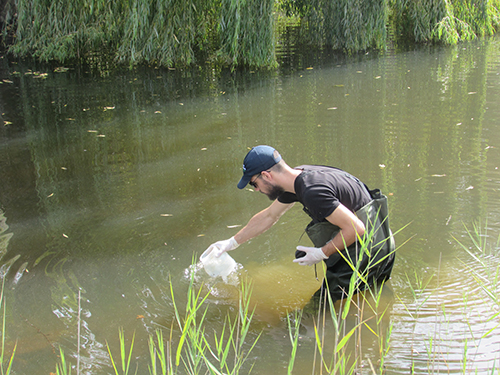Environmental DNA
Our eDNA team use specialist genetic tools to detect natives and invaders.
Traditional methods of species monitoring can be expensive and challenging. However researchers at the Institute for Applied Ecology (IAE) have developed sensitive and cost-effective methods to confirm if a species is present in an area. This method uses traces of DNA that species
leave behind in the environment, e.g. scats, tissues and freshwater samples, and is called Environmental DNA or eDNA. Applications include detection of invaders, or rare species of conservation concern. Our team are experts in sample collection, processing and analysis.
What we do
- Develop eDNA assays for the detection of a single target species and validate it both in the laboratory and the field
- Multi-species detection using eDNA meta-barcoding that enables an inventory of biodiversity present in a water sample
- Detection of terrestrial species from eDNA samples derived from water sources, such as feral pigs, horses, wild dogs
Our Facilities
- eDNA sampling equipment and specialist water filtering facilities
- Trace DNA laboratory for handling eDNA samples
- Separate pre and post PCR facilities for QA/QC protocols
- Sample preparation in accredited PC2 laboratories
- Reference DNA and tissue databases
- Animal holding facility, including freshwater and terrestrial
Our Partners
The University of Canberra host the Centre for Invasive Species Solutions and partner with them in the development of technologies to support eDNA advancements. We are also a key collaborator with the CSIRO on the Future Science Platform ‘Environomics’.
To find out more about eDNA at the IAE please visit the Centre for Conservation Ecology and Genomics website.
Development of a detection probability framework
 Environmental DNA (eDNA) is increasingly used as a survey tool to infer species distributions. eDNA has advantages over traditional detection tools as it is non-invasive, samples are often easy to collect, and it reduces the need for taxonomic expertise. The technique does, however, require careful evaluation of sensitivity.
Environmental DNA (eDNA) is increasingly used as a survey tool to infer species distributions. eDNA has advantages over traditional detection tools as it is non-invasive, samples are often easy to collect, and it reduces the need for taxonomic expertise. The technique does, however, require careful evaluation of sensitivity.
Researchers at the IAE have developed a framework to estimate the sensitivity of both the field and laboratory components of this method, and combine them to estimate overall sensitivity. This framework can be applied to species-specific eDNA surveys to estimate the sensitivity, or probability of detection, for three invasive aquatic species in Australia; redfin perch (Perca fluviatilis), carp (Cyprinus carpio), and Oriental weatherloach (Misgurnus anguillicaudatus).
To utilise eDNA as a management tool, the sensitivity of eDNA detection surveys has to be estimated and accounted for. This framework enables researchers to quantify overall sensitivity of a particular eDNA survey method, and to optimise sampling regimes. This ultimately provides the most robust data to inform management actions.
Photo Credit: Elise Furlan
Invasive species management
 Once an invasive species becomes established, containment can provide an effective management option. This only works, however, if distribution limits are accurately detected.
Once an invasive species becomes established, containment can provide an effective management option. This only works, however, if distribution limits are accurately detected.
Improved sensitivity of eDNA-based surveys makes this method particularly useful to determine outer distribution limits. Researchers at the IAE compared conventional monitoring methods and eDNA-based monitoring to determine the spread of the invasive redfin perch (Perca fluviatilis) in an intermittent river system. This voracious predatory fish is responsible for the continued decline of several threatened and vulnerable species in Australia, and in this system was a potential threat to the native and threatened Southern pygmy perch (Nannoperca australis). They demonstrated that eDNA was more sensitive than traditional methods and the combination of conventional and eDNA-based monitoring vastly improved redfin perch distribution data resulting in the optimal location for the construction of an exclusion barrier. This is one of the first eDNA studies to demonstrate a clear management outcome.
Photo Credit: Jonas Bylemans
Detection of spawning in threatened species

IAE researchers have detected spawning of a threatened freshwater fish species, Macquarie perch, by comparing the abundance of different types of eDNA produced during the spawning period. Previously, the detection of spawning in this species has been carried out using labour intensive egg-netting methods that have the potential to miss these sporadic events. This eDNA method can help evaluate whether population declines are caused either by spawning failure or high mortality rates of the early life history stages.
Photo Credit: Ben Broadhurst

